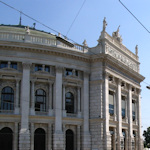
Gustav Klimt painted some of its ceiling frescoes and a litany of famous actors crossed its stage: the Burgtheater is a city treasure. The in-house tour takes you on a journey through the theatre’s past and present (and up close to Klimt’s works).
- Guide covers the building’s history, art, and personalities
- Plenty of entertaining anecdotes
- At the time of writing: German tours only with written English summaries
- Book a guided walking tour* of historical Vienna
- See also:
Klimt and more

(The main entrance of the 19th-century theatre)
One particularly magnificent cultural building stands out as a mighty bastion against the overwhelming influence of music in Vienna: the Burgtheater. The national theatre is dedicated to the spoken word only.
Go through the entrance and it all looks a little less magnificent inside (a consequence of WWII bombing).
However, first impressions mislead, for the Burgtheater provides a home for two rather glorious staircases and globally-important works of art that survived the bombers.
The institution sits at the centre of German-language theatre in Austria, so you probably won’t be buying a ticket to a play (although a subtitle service exists for some performances).
That doesn’t mean you can’t look around inside: the in-house tours take you to both historical entrance halls, the auditorium, the stage, and various bits in between.
Tour highlights
The stand-out stops on the tour are those two hallways featuring broad staircases (all marble, stone, and richly-decorated lamps), as well as busts and statues honouring actors and playwrights such as Nestroy, Molière, and David Garrick.

(The grand staircase, as painted around 1910 by Rudolf Konopa and produced by Brüder Kohn KG (B. K. W. I.); Wien Museum Inv.-Nr. 34745/4; excerpt reproduced with permission under the terms of the CC0 licence)
Original paintings from the late 1880s cover each hallway ceiling with representations of theatrical history and themes, whether a medieval mystery play or a performance of Romeo and Juliet at the Globe Theatre.
Klimt!
Of course, what makes these ceiling paintings special is the names of the artists behind them: Frank Matsch, Ernst Klimt, and (drum roll) Gustav Klimt.
The more famous Klimt contributed, for example, The Altar of Dionysos, The Cart of Thespis, and The Theatre at Taormina paintings. You can already begin to see subtle echoes of the style that would later appear in such iconic works as The Kiss.
Incidentally, Vienna’s Leopold Museum recently received Klimt’s draft painting of The Altar of Dionysus as a donation, so the work might pop up in their permanent exhibition.
Gustav Klimt also created the aforementioned painting of the Globe, which incorporates the performance and various onlookers.
Three young men in the Globe audience deserve special mention since these are portraits of Matsch and the two Klimt brothers.
That innocuous addition remains the only painted self-portrait by Gustav Klimt known to be in existence. Klimt himself even once wrote a Commentary on a non-existent self-portrait, noting (my rough translation):
I’m not interested in my own person as an object of a picture
Adding later in that short text:
I’m convinced I’m not particularly interesting as a person
Yeah, right.

(The Cart of Thespis ceiling fresco painted by Gustav Klimt; photographed when the paint was almost still wet in around 1890; Wien Museum Inv.-Nr. 95340/43; excerpt reproduced with permission under the terms of the CC0 licence)
And the rest…
On my tour, the route between staircases took us through foyers and interval rooms, where the rich tradition of the Burgtheater comes alive in various artifacts and mementos.
So you see, for example:
- The death mask of Oskar Werner, former member of the Burgtheater ensemble and winner of a Golden Globe for his performance in The Spy Who Came in from the Cold
- Portraits of such theatrical luminaries as Katharina Schratt (a leading actress and long-time friend of Emperor Franz Joseph) or Joseph Lange (actor and Mozart’s brother-in-law)
The route also provides an opportunity to look out the windows for lovely views across to the Rathaus and other parts of Vienna’s historical centre.
The auditorium and stage were closed for rehearsals on my tour, but the guide took time to show photos and explain, for example, the finer points of the stage’s technology.
(NB: The box office kindly warned us about the shortened tour before we bought our tickets.)
Throughout the tour, my guide gave an authoritative and entertaining account of the theatre’s history, the ensemble, and the characteristics of every location, including details of each painting we passed. A true fount of knowledge full of anecdotes and insight.
Tickets & visitor tips
Check locally with the theatre for current and coming tour schedules (and availability in different languages and on different days: rehearsals can cause adjustments in the tour route, for example).
Pre-2020, the Burgtheater had tours most days, with English-language versions available at weekends and throughout July and August, for example.
More recently, tours have been towards the end of the week and German-only, though with written multilingual summaries for international guests.
You buy your tickets direct from the box office on the day.
The Burgtheater is, of course, not the only historical building where you can tour the interior. Try some of these suggestions, too.
How to get to the Burgtheater
See the main article on the Burgtheater for travel info. Go through the main front entrance to find the box office on your right.
Address: Dr. Karl-Lueger-Ring 2, 1010 Vienna